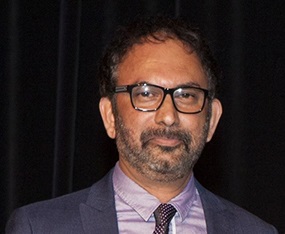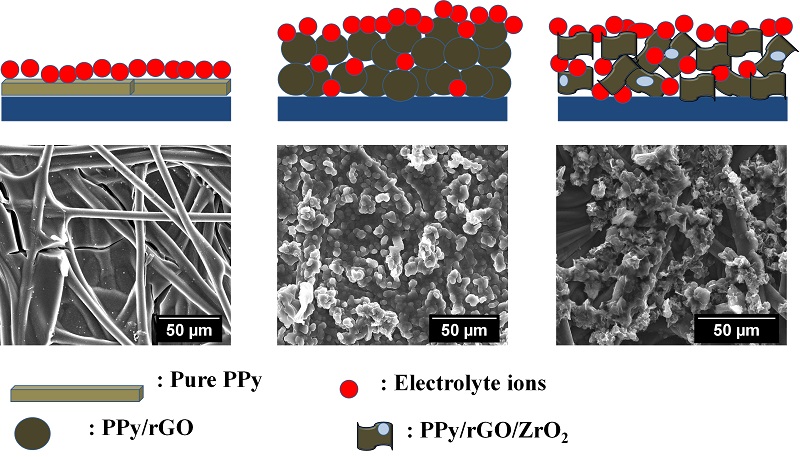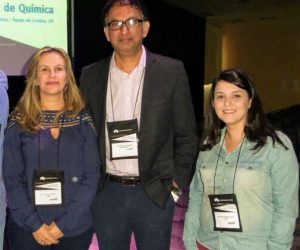|
|||||||||||||||||||||||||||||||||||||||||||||||||||||
|
|||||||||||||||||||||||||||||||||||||||||||||||||||||
|
|
|||||||||||||||||||||||||||||||||||||||||||||||||||||
|
|||||||||||||||||||||||||||||||||||||||||||||||||||||
|

Despite all the knowledge on nanotechnology generated over the last few decades, applying nanomaterials to commercial products can still be a difficult task. At the XVI B-MRS Meeting, Professor Pulickel Ajayan, one of the world’s references in nanomaterials and nanostructures, will shed light on this problem. In the plenary lecture he will address in Gramado on the morning of September 14, Ajayan will discuss some challenges of the application of nanomaterials (particularly those of two dimensions) in systems and devices. He will address issues related to the synthesis, characterization and modification of these materials.
Ajayan and his collaborators have developed nanomaterials with diverse functionalities, applicable to fileds such as energy storage and conversion, catalysis, low consumption electronics, nanomedicine or environment care. Among his most famous contributions, are carbon nanotubes filled with molten material acting as nanowire moulds (1993); nanobrushes made of carbon nanotubes, highlighted by Guinness World Records as the smallest ones (2005); the paper battery, made of cellulose and nanotubes (2007); the ultra-dark nanotube carpet, which reflects only 0.045% of light (2008), and a reusable sponge of nanotubes capable of absorbing oil dispersed in water (2012).
Professor and director of the Department of Materials Science and Nanoengineering at Rice University (USA), Ajayan has exceptional publication metrics: a h index of 144 and more than 95,000 citations according to Google Scholar.
Pulickel Madhavapanicker Ajayan was born in 1962 in India, in a small town in the southern state of Kerala. He attended primary school there and then went to the state capital, to a high school that aroused his enthusiasm for learning, his curiosity, and his interest in science.
In 1985, Ajayan graduated in Metallurgical Engineering at Banaras Hindu University (BHU), located in northeastern India and then went on to do a PhD in Materials Science and Engineering at Northwestern University (USA). At that moment, he began to penetrate nanotechnology. In 1989, he defended his PhD thesis about very small gold particles that, some years later, would begin to be called “nanoparticles”.
In 1990, he moved to Japan to pursue a postdoctoral stage at the Fundamental Research Laboratory of the NEC Corporation, where he remained until 1993 in the group that was responsible for a series of seminal studies on carbon nanotubes – including the “discovery” of these nanomaterials, attributed to Sumio Iijima in 1991. During his postdoc, Ajayan obtained important results on the synthesis of nanotubes in large scale and on the filling of nanotubes with other materials.
From Japan, he went to France where he worked as a researcher at the Solid Physics Laboratory of the Université Paris-Sud for two years. Then he went to Germany, where he worked for a year and a half at the Max-Planck-Institut für Metallforschung. In 1997, he moved to the United States to become an assistant professor at the Rensselaer Polytechnic Institute (RPI), the nation’s oldest university of technological research, located in the state of New York. At RPI, he was the Henri Burlage chair Professor in Engineering and worked in the nanotechnology research group.
In 2007, he left RPI and joined the faculty of the Department of Mechanical Engineering and Materials Science at Rice University to be the Benjamin M. and Mary Greenwood Anderson professor of Engineering. In 2014, he also held the founding chair of the Department of Materials Science and NanoEngineering.
Currently, in addition to teaching and leading a research group of about 40 members at Rice University, Ajayan travels a lot, whether to share his knowledge on nanotechnology (he has delivered more than 350 invited lectures and has held visiting professor positions at universities around the world), or to take care of his scientific collaborations. In addition, Ajayan has acted on the boards of several journals, startups and international conferences of the materials and nanotechnology field.
The scientist has received important awards from a number of institutions including the Royal Society of Chemistry (UK), Alexander von Humboldt Foundation (Germany), Materials Research Society (USA), Microscopic Society of America (USA). He also received distinctions of numerous universities around the world, including the doctorate honoris causa by the Université Catholique de Louvain (Belgium). He is an elected member of the Royal Society of Chemistry (UK), American Association for the Advancement of Science (AAAS), and the National Academies of Sciences of India and Mexico, among other scientific societies.
Here follows an interview with the scientist.
B-MRS newsletter: – We would like you to choose some of your contributions to nanotechnology, describe them briefly, and share the paper reference, if possible. Please choose:
– The one(s) you consider to have caused or will cause more social impact.
Pulickel Ajayan: – Several of our discoveries have commercial and social impact. In the past two decades some of the research highlights from our lab have been carbon nanotube arrays as extreme light absorbers (for thermo-photovoltaics), nanotube arrays as gecko-tapes, high conductivity carbon nanotube fibers, graphene oxide membranes for water filtration, carbon nanomaterials for energy storage, light weight polymer nanocomposites, development of two-dimensional materials for electronics and sensors, carbon based quantum dots as catalysis for example CO2 reduction etc.
– The one(s) that gave you more personal satisfaction.
Pulickel Ajayan: – One of the most exciting work was related to the conversion of carbon onions into diamond nanoparticles using electron irradiation. This work was done in collaboration with Prof. Florian Banhart when I was visiting as a post-doc at the Max Planck Institute for Metallforschung in Stuttgart in the mid-90’s. This work published in Nature magazine showed direct observation of graphite to diamond phase transition without application of any external pressure.
B-MRS newsletter: – Have any of your scientific/ technological contributions been transferred to a commercial product? If so, has this transfer occurred through patent licensing, start-up …?
Pulickel Ajayan: – Two start-up companies (Paper Battery Co. and Big Delta Systems) have come out of our work; both engage in unconventional energy storage technologies.
B-MRS newsletter – Leave an invitation to your plenary talk for our readers.
Pulickel Ajayan: – Nanotechnology is a paradigm changing approach on how we will be building materials of the future. It is at the core of bottom-up manufacturing and will impact several areas of future technologies. Our work in the past two decades have focused on creating nano-engineered materials with various types of nanoscale building blocks.
More information
On XVI B-MRS Meeting website, click on the photo of Pulickel Ajayan and see his mini CV and the abstract of his plenary lecture: http://sbpmat.org.br/16controter/home/
[Paper: One-step electrodeposited 3D-ternary composite of zirconia nanoparticles, rGO and polypyrrole with enhanced supercapacitor performance. Alves, Ana Paula P.; Koizumi, Ryota; Samanta, Atanu; Machado, Leonardo D.; Singh, Abhisek K.; Galvao, Douglas S.; Silva, Glaura G.; Tiwary, Chandra S.; Ajayan, Pulickel M. NANO ENERGY, volume 31, January 2017, 225–232. DOI: 10.1016/j.nanoen.2016.11.018.]
Advanced material for ultra-capacity supercapacitors.
Supercapacitors are electrical storage devices with a particular feature of releasing large amounts of energy in a short time interval. They are already used, for example, in electric or hybrid vehicles, camera flashes and elevators, but they can still be improved – largely with the contribution of Materials Science and Technology – for current and potential applications. Putting it simply, a supercapacitor consists of two electrodes, positive and negative, separated by a substance containing positive and negative ions (the electrolyte).
An article recently published in the scientific journal Nano Energy (Impact Factor 11,553) reports on a contribution from an international and interdisciplinary scientific team to develop materials that improve the performance of supercapacitors. Using a simple and easily scalable process, the team of researchers from Brazil, the United States and India produced electrodes made of a composite material composed of polypyrrole (PPi), reduced graphene oxide (rGO) and zirconium oxide (ZrO2) nanoparticles. By combining the three materials, the scientists were able to generate a large surface area and high porosity electrode – basic characteristics to promote the interaction of the electrolyte ions with the surface of the electrodes and therefore enhance the performance of the supercapacitor.
“Our unique contribution was the synthesis, in a single and simple stage of electrodeposition, of a hybrid containing graphene, zirconium oxide and polypyrrole, and the experimental demonstration of considerable gains in electrochemical properties, parallel to the theoretical modeling in order to understand the role of the components of the material”, states Glaura Goulart Silva, professor in the Department of Chemistry at the Federal University of Minas Gerais (UFMG) and a corresponding author of the paper.
In addition to preparing samples of the ternary (i.e., composed of three elements) composite PPi/rGO/ZrO2, using the same method for comparison purposes, the team prepared samples of the PPi/rGO binary composite, and pure polypyrrole samples. The three materials were analyzed using XPS (spectroscopy of X-ray excited photoelectrons), SEM (Scanning Electron Microscopy), Raman spectroscopy and transmission electron microscopy to determine their composition, structure and morphology.
As seen in the SEM images of the figure below, the scientists noted that the addition of graphene oxide and zirconia nanoparticles significantly changed the morphology of the material. While the pure polypyrrole had formed a cracked, wire-like film, the graphene composite had a granular morphology, with no cracks, and the zirconium oxide material had a leaf-like appearance.
At the end of the experimental stage of the study, the scientists performed a series of tests to measure the performance of the three materials as supercapacitors. The results showed that the capacity to store electrical charges (capacitance) had increased up to 100% in the ternary composite with respect to the polypyrrole. Moreover, instead of decreasing this performance due to the use of the electrode, it increased by 5% after 1,000 recharges in the binary and ternary composites.
This was the first paper that presented the introduction of zirconium oxide nanoparticles in polypyrrole and graphene electrodes for supercapacitors. Therefore, the team performed computational modeling to analyze the role of zirconium oxide in the performance of the composite. The simulations confirmed the beneficial effects of the nanoparticles on the stability of the material, directly related to extending the life of the electrodes.

“There is great potential in the application of these new composites in supercapacitors due to the need to increase the energy density provided by the device, in parallel with its miniaturization,”declares Professor Goulart Silva. “The alternative developed in the work in question allows better performance in terms of cycling stability with gains in the safety of the supercapacitor. The use of supercapacitors and batteries in electric and hybrid cars is one of the technological fronts where these materials can be applied,” she adds.

The work is part of the doctorate in Chemistry of Ana Paula Pereira Alves, conducted with the guidance of Professor Goulart Silva and defended in February of this year at UFMG with a thesis about synthesis and characterization of advanced materials for supercapacitors. During her doctoral work at the University of Minas Gerais, Pereira Alves carried out intensive training in synthesis techniques and physical-chemical analysis of conjugated polymers and graphene and in the characterization of supercapacitors. In 2015, she went to the United States for a one-year “sandwich” internship, with the support of the National Council for Scientific and Technological Development (CNPq), in the Department of Materials Science and Nanoengineering at Rice University, in the research group of Professor Pulickel Ajayan (researcher with h=139 index according to Google Scholar), who has collaborated with Professor Goulart Silva’s group since 2010. “Professor Ajayan has systematically proposed radical innovations in synthesis and design of batteries and supercapacitors, with significant international impact in the area,” she adds.
The experimental work reported in the paper was carried out at Rice University, with the presence of all authors, including those from Brazil and India, and also Professor Goulart Silva, who was there in February 2016, with the support of Minas Gerais Research Foundation (Fapemig). “The highly interdisciplinary environment of the Department of Materials Science and NanoEngineering at Rice made possible for the engineers, physicists, and chemists to come together to work on a current major problem.”, says Goulart Silva.
The computational modeling was carried out by Brazilian researchers from the State University of Campinas (Unicamp) and the Federal University of Rio Grande do Norte (UFRN) –among them Professor Douglas Galvão (Unicamp), who has maintained a scientific collaboration with Professor Ajayan since before the beginning of this research.
“I consider this work to be an excellent example of success, where the competence of the Brazilian groups joined that of a highly productive and impactful group in the international scenario and complement each other,” declares Goulart Silva. “The stability and increase of investments in research and development in Brazil are essential for endeavors as this to be widespread. Research is an investment that needs to be done over the long term, without setbacks, to enable a high rate of return in terms of materials, technologies and highly qualified people. Ana Paula Alves is now a young doctor in search of the opportunity to put together her research group and hence train new students and hence contribute to face the challenges of our country,” reaffirms Goulart Silva.